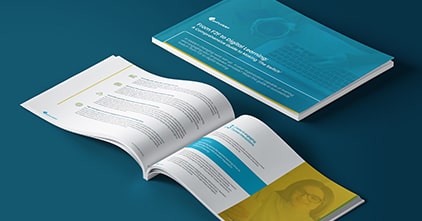To measure whether or not your corporate training efforts are effective, learners should also assess their own skills and knowledge for learning leaders to get a holistic understanding of the current workplace learning situation. So here are some tips for learners to evaluate their skills gained from workplace learning:

Whether you’re an L&D leader, HR professional, or an employee who undergoes training and learning in the workplace, it’s important to be an active agent in the overall learning process.
Aside from getting insights from data stories, learning leaders can look into employees’ self-evaluations. As a learner, one way you can do your part is by assessing yourself through gained skills and knowledge from training and help your learning department know your individual learning needs, goals, and skills gaps.
To do this, follow these actionable tips to easily evaluate whether or not you’re getting the most out of your learning in the workplace:
Review your job description
First things first — look at your own job description to see what skills and knowledge were listed as requirements. This is also a great way to know whether or not you’re meeting the company’s expectations from you. Ask yourself:
- Have I gained more skills aside from what’s mentioned in the job description?
- Is the training program helpful in advancing my current skills and those listed there?
- What new skills did I gain aside from those in the description?
- How am I applying the new set of skills I got from my corporate training program?
The easiest ones to look at are hard skills like programming, marketing skills, and financial modeling since you’ve most probably gained them from school and training at work.
But when going through your hard skills, a better approach is to focus on the specifics. For example, instead of saying that you’re proficient in using Excel or Google Sheets, you should rather talk about specific tools you’ve mastered like writing formulas and creating pivot tables.
With this, you’ll be able to look into your current skills pool, compare what new ones you’ve got, and what skills you’ve managed to improve or advance when you took your organization’s training program.
Zero in soft skills
Moving on, it’s best to look beyond technical skills. Probably, as we’ve realized, some of the most critical business and professional skills aren’t taught in a traditional classroom set-up. We call them soft skills.
Simply put, soft skills include verbal and written communication, critical and analytical thinking, and leadership skills. In fact, according to the Business Insider, in the age of automation, these skills are becoming more relevant regardless of how much tech has overtaken your job. Because there are still so many skills that one can’t teach a computer.
Here’s the point: beyond your technical know-hows, you should also focus on soft skills and assess how your training program has positively impacted these skills. This can also be a way for you to gauge your improvement especially if you have concerns about communicating with foreign colleagues and clients, for instance.
When you self-assess your soft skills, you can also help your L&D and HR leaders through giving them feedback and raising your concerns regarding the training program and suggest how soft skills can be more emphasized.

Look at your exam results
As you know, one of the most concrete measures of improvement in knowledge and skills is through administering and taking exams. It’s done in majority, if not all, of educational institutions around the world. One benefit from this is that you can easily look at your exam score or grade and see how well you did for that test.
For instance, if you’re wondering whether or not your language fluency has improved, you can take a language leveling test and easily assess your business language skills and know your current language level based on set metrics and standards.
Even better, L&D and HR professionals can arrange practical tests for some skill-based training. This gives you a more experiential and on-the-job evaluation of your current skills. For example, a practical test on business presentations using French can help you assess whether or not you can already present with French clients using the target language.
Write a performance self-evaluation
The thing here is that employee self-evaluation is said to be an effective method to engage employees in training and development. As a learner, you’ll be able to see your strengths and weaknesses and relate them to how corporate training plays a part in your overall performance, learning, and professional development.
So here are some useful tips to help you create a self-assessment:
- List your accomplishments and see how these are related to skills gained from your training program.
- Write a list of your struggles to how training can help you with these problems.
- Don’t forget to align your review with your manager’s or team’s goals.
- Keep the focus on you and your experience with the training program.

Consult your mentor
A mentoring culture at work is an essential factor in the overall growth of your organization since it encourages a continuous learning process and prevents your company from spending too much on rehiring new employees.
If you currently have a mentor or mentors, it’s best to consult them about your work performance and how your job has been influenced by your training program. Actually, you can ask for their feedback whether you’ve relatively improved your work and have applied the skills and knowledge from your corporate training courses to your current projects.
Better yet, you can reframe the question and ask for the areas of work you can still improve on and in what things or tasks do you still lack skills and knowledge for. This way, you and your mentor can immediately collaborate and discuss with the HR or L&D department what other training programs may seem beneficial for you.
Ask for 360-degree feedback
Here’s the point: to evaluate yourself, you also need the feedback of different people you encounter at work — colleagues, managers, mentors, teammates, etc. Because of their combined insights, you’ll be able to have a more meaningful conclusion as to how corporate training may or may not contribute to how you’ve gained skills and applied them to your daily tasks at work. Aside from this, if necessary, you can also ask for feedback from some of your clients and customers to see how your skills are being applied on-the-job and on-the-field.
For example, you’re a sales representative taking a Mandarin course for your language training program. To get a more meaningful insight to your performance, ask your managers, peers, and some of your clients whether or not you’re improving on using Mandarin in business meetings, written reports, and such tasks and activities.
Make sure that you always tie your questions to how the training program may or may not have helped you at work.
Gather analytics
It’s true that data talks!
So you should always look into quantifiable data to assess yourself whenever possible. Aside from qualitative feedback from different people you work with and self-assessing yourself through performance, you should also see the numbers and data.
For example, instead of saying that “The number of deals I managed to close increased”, you should state that “I increased my closed deals by 20 percent” which makes it more concrete and quantifiable. This also gives you more opportunities to set more objective goals instead of vague ones.

The Takeaway
To sum it all up, it’s always important to self-assess and determine your current pool of skills and knowledge to determine how your corporate training program has been affecting your job performance. This way, you can easily coordinate with your L&D or HR department and align training to more priority skill sets based on your needs and goals.
More so, HR and L&D managers should also encourage their employees to always do a self-assessment to diagnose current skills gaps and maximize the overall impact of their current training programs which can contribute to the overall success of the organization.




